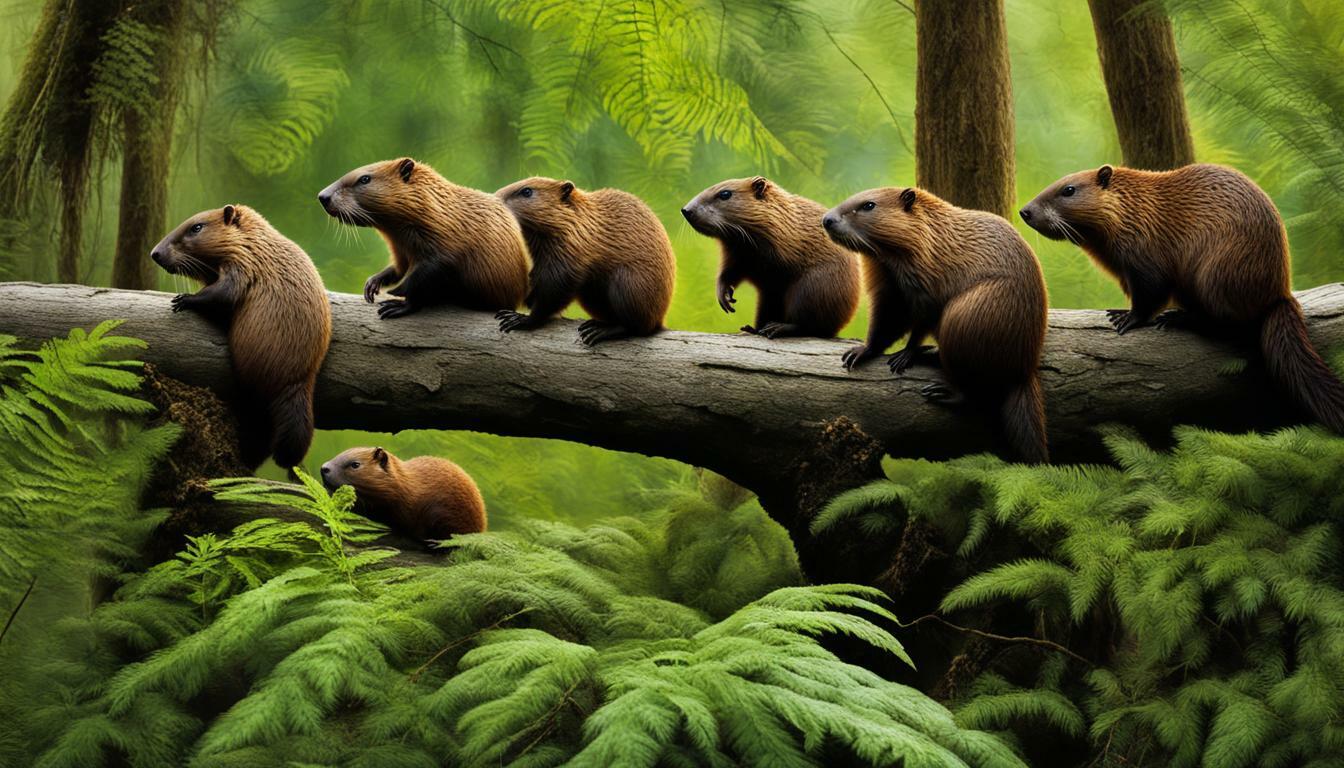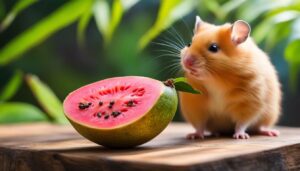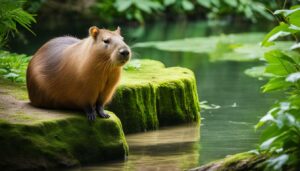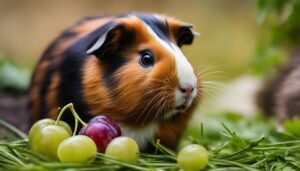Have you ever wondered if beavers have the ability to climb trees? Let’s explore the fascinating behavior of these industrious creatures.
Key Takeaways:
- Beavers cannot climb trees due to their physical attributes.
- They have a heavy build, webbed feet, poor eyesight, and bottom-heavy anatomy.
- While they excel in tree-felling and chewing, climbing trees is not within their capabilities.
- Beavers rely on trees for building dams, lodges, and as a food source.
- However, they navigate their environment on the ground with resourcefulness and problem-solving abilities.
Understanding Beaver Characteristics
To understand why beavers cannot climb trees, it’s important to look at their unique characteristics. Beavers possess a heavy build, which makes climbing difficult for them. Their bodies are designed for life in the water, with webbed feet that are perfect for swimming and navigating through their aquatic habitats.
Another factor that affects their climbing abilities is their poor eyesight. Beavers rely heavily on their senses of hearing and smell to detect danger and locate food. Their eyesight is not well-suited for judging distances or accurately assessing the stability of tree branches, which further inhibits their climbing capabilities.
Furthermore, a beaver’s anatomy plays a significant role in their inability to climb trees. They have a bottom-heavy build, with a large, muscular tail that aids in propulsion while swimming. This tail, along with their robust bodies, makes it challenging for them to ascend vertical surfaces like tree trunks.
| Characteristic | Effect on Climbing |
|---|---|
| Heavy build | Makes climbing difficult |
| Webbed feet | Designed for swimming, not climbing |
| Poor eyesight | Limits their ability to assess tree branches |
| Bottom-heavy anatomy | Hinders their ability to ascend vertical surfaces |
The Science Behind Tree Climbing Skills
While many animals have evolved specific traits to help them climb trees, beavers have adapted differently. Due to their heavy build, webbed feet, poor eyesight, and bottom-heavy anatomy, tree climbing is a skill that eludes them. Unlike squirrels, monkeys, or even some rodents, beavers are not designed to navigate vertical surfaces.
Beavers rely on their remarkable tree-felling and chewing abilities to shape their environment. They use their strong incisors to cut through the trunks of trees, bringing them down to build dams and lodges. However, their lack of climbing skills means that they must stay on the ground or in the water, where they feel most at home.
Their inability to climb trees is intrinsically linked to their reliance on them. Beavers depend on trees for various reasons. They use the trunks and branches to construct their dams and lodges, creating a safe and sheltered habitat. Trees also serve as a valuable food source for beavers, who mainly consume the bark and leaves.
| Beaver Adaptations for Tree Climbing | Notable Features |
|---|---|
| Heavy Build | Beavers have a stocky, robust build that aids them in swimming and diving but hinders their ability to climb trees. |
| Webbed Feet | Their webbed feet are excellent for propelling them through water but are not conducive to gripping and ascending tree bark. |
| Poor Eyesight | Beavers have poor eyesight, making it even more challenging for them to navigate the complex network of branches found in trees. |
| Bottom-Heavy Anatomy | Their large, flat tail and bottom-heavy anatomy provide stability when swimming and diving but are a hindrance when it comes to climbing vertical surfaces. |
Despite their limitations, beavers are highly skilled at felling trees. They strategically choose which trees to bring down, often favoring those that are close to water sources or have young, succulent branches. By felling trees, beavers shape their environment and create habitats that benefit not only themselves but also other species.
Beavers’ Relationship with Trees
Despite their inability to climb trees, beavers rely heavily on them for various aspects of their survival. Trees play a crucial role in a beaver’s life, serving as the foundation for their construction projects and as a vital food source.
Beavers are renowned for their remarkable skills in felling trees. Using their powerful jaws and sharp incisors, they can bring down even large trees to build dams and lodges. These structures provide protection for beavers against predators and create suitable habitats for their families.
Furthermore, trees are an essential part of a beaver’s diet. They primarily feed on the bark, twigs, and leaves of various tree species. Their ability to chew through wood allows them to access the nutrient-rich inner layers of the tree, providing sustenance for their survival.
| Benefits of Trees for Beavers | Examples |
|---|---|
| Building materials for dams and lodges | Cutting down trees to create structures |
| Protection against predators | Creating a safe environment for their families |
| Food source | Feeding on bark, twigs, and leaves |
Without the presence of trees, beavers would face significant challenges in their natural habitat. Trees are not only integral to their physical well-being but also contribute to the overall health and balance of the ecosystem they inhabit.
Conclusion
In conclusion, while beavers cannot climb trees, they heavily rely on them for their survival. From building dams and lodges to providing nourishment, trees play a fundamental role in the lives of these fascinating creatures. Their tree-felling abilities and resourcefulness on the ground make up for their climbing limitations, showcasing the remarkable adaptability of the beaver species.
The Art of Tree Felling
Although beavers cannot climb trees, they certainly know how to bring them down with incredible precision. These industrious creatures have mastered the art of tree felling, utilizing their strong teeth and powerful jaws to chew through even the toughest of trunks. But it’s not just their sheer strength that allows them to fell trees; it’s also their strategic approach and impeccable timing.
When a beaver identifies a suitable tree for felling, it begins by gnawing around the base, creating a notch that determines the direction of the fall. By constantly chewing and removing wood from this notch, the beaver weakens the tree’s support structure. Once the tree starts to lean, the beaver quickly moves to the opposite side and continues to chew until the tree falls in the desired direction.
The Science of Precision
Beavers’ incredible precision in tree felling is not a coincidence. It is a result of their innate understanding of a tree’s anatomy. The beaver’s gnawing technique takes advantage of the fact that the bark and cambium layer, which transport nutrients, are closest to the outer surface of the trunk. By chewing around the base, the beaver effectively severs the vital nutrient supply, leading to the tree’s demise.
| Benefits of Tree Felling for Beavers | |
|---|---|
| 1. Building Material | Beavers use the felled trees to construct their elaborate dams and lodges. The branches and logs are woven together to create sturdy structures that provide shelter and protection. |
| 2. Food Source | Beavers rely on the inner bark and tender shoots of trees as a primary food source. The felled trees allow easier access to these nutritious parts, ensuring the beavers’ survival. |
| 3. Accessible Waterways | By strategically felling trees, beavers create pathways for water to flow, allowing them to manipulate their environment to suit their needs, regulate water levels, and create a habitat rich in resources. |
While beavers may not possess the ability to climb trees, their remarkable tree-felling skills demonstrate their adaptability and resourcefulness in navigating their environment on the ground.
Navigating Life on the Ground
Without the ability to climb trees, beavers have developed alternative strategies to thrive in their habitat. While other rodents may effortlessly scurry up trees, beavers have adapted to life on the ground, showcasing their resourcefulness and problem-solving abilities.
One way beavers navigate their environment is by using their strong and agile bodies to swim. With their webbed feet and streamlined physique, they are excellent swimmers, able to effortlessly glide through water. This aquatic prowess allows them to reach different areas of their habitat, access food sources, and escape from predators.
Beavers also rely on their keen sense of touch and smell to navigate their surroundings. Their poor eyesight is compensated by their highly developed senses, which help them detect potential threats and locate necessary resources. By relying on their sharp sense of smell and sharp hearing, beavers are able to find their way and interact with the environment around them.
| Alternative Strategies of Beavers on the Ground | |
|---|---|
| Swimming | Beavers are expert swimmers, utilizing their webbed feet and streamlined body to navigate through water and access different areas of their habitat. |
| Senses | With their poor eyesight, beavers rely on their sharp sense of touch and smell to detect potential threats and locate necessary resources. |
Furthermore, beavers construct intricate networks of dams and lodges using the very trees they cannot climb. By utilizing their impressive tree-felling abilities, beavers create barriers and structures that not only provide shelter but also regulate water flow in their aquatic environment. These structures serve as their homes, offering protection from predators and adverse weather conditions.
Although beavers may not possess the ability to climb trees, their adaptation and ingenuity on the ground enable them to thrive in their habitat. By relying on swimming, their heightened senses, and their remarkable skills in tree felling and construction, beavers have found innovative ways to make the most of their environment without the need to climb.
| Beavers’ Adaptation on the Ground | |
|---|---|
| Dam and Lodge Construction | Beavers use their tree-felling abilities to create dams and lodges, which provide shelter and regulate water flow in their habitat. |
| Innovation and Adaptability | Despite their inability to climb trees, beavers have adapted and found alternative strategies to thrive on the ground. |
The Role of Trees in Beaver Dams and Lodges
Despite their inability to climb trees, beavers use their tree-felling abilities to create intricate dams and lodges. These structures play a crucial role in their survival and provide a safe habitat for the beaver family.
Beavers are renowned for their tree-felling skills, using their sharp incisors to gnaw through the trunks of trees. They carefully choose the right trees, usually those close to water bodies, to build their dams and lodges. By strategically felling trees and placing them across streams or rivers, beavers create dams that control water flow and create a pond-like environment.
Beaver dams serve multiple purposes. They provide protection for the beavers from predators, regulate water levels, and create a suitable habitat for aquatic plants and animals. The ponds created by these dams offer a safe place for beavers to build their lodges. The lodges are constructed with sticks and mud, providing a comfortable living space above the waterline.
| Beaver Dam | Beaver Lodge |
|---|---|
| Beaver dams control water flow and create ponds. | Beaver lodges are built above the waterline. |
By relying on their tree-felling abilities, beavers shape their environment to suit their needs. They transform landscapes, creating habitats that support an array of plant and animal species. Despite not being able to climb trees, beavers have become known for their impressive engineering skills, demonstrating the remarkable ways in which animals adapt to their surroundings.
Beavers’ Food Source
Trees serve as a vital source of nutrition for beavers, even though they are unable to climb them. These industrious creatures rely on their impressive tree-felling skills to access this essential food source. Beavers have a diverse and adaptable diet, but their primary sustenance comes from the bark, twigs, and leaves of various tree species.
When it comes to selecting their meals, beavers demonstrate a preference for certain tree species. They particularly favor the taste of deciduous trees such as aspen, willow, and birch. These trees not only provide nourishment for beavers but also contribute to their dental health. Chewing on the fibrous bark helps wear down their continuously growing incisors, preventing overgrowth and maintaining proper dental function.
To efficiently gather food, beavers use their strong jaws and sharp teeth to fell trees. They methodically gnaw through the trunk, creating a strategic notch that directs the tree’s fall in the desired direction. Once the tree is down, they strip away the outer bark and consume the nutrient-rich inner layers.
| Preferred Tree Species | Contributions to Beaver Diet |
|---|---|
| Aspen | Provides nourishment and dental health benefits |
| Willow | Rich source of nutrients for beavers |
| Birch | Contributes to beavers’ dietary needs |
As beavers consume the bark and foliage of trees, they play a significant role in shaping the surrounding ecosystem. Their selective feeding habits can influence the abundance and distribution of tree species in their habitat. By felling and utilizing trees as a food source, beavers contribute to the natural balance and diversity of their environment.
The Limitations of Being Ground-Dwelling Creatures
While beavers possess remarkable skills and adaptations, their inability to climb trees imposes certain limitations on their behavior. Due to their heavy build and bottom-heavy anatomy, climbing becomes a challenging task for these aquatic rodents. Their webbed feet, which are ideal for swimming and maneuvering in water, are not well-suited for gripping tree trunks or branches. Additionally, beavers have poor eyesight, further hindering their ability to navigate tree canopies.
Despite these limitations, beavers have found ingenious ways to thrive in their ground-dwelling habitat. They display remarkable resourcefulness and problem-solving abilities, navigating their environment with ease. Beavers are renowned for their tree-felling skills, using their powerful jaws and sharp incisors to bring down trees. This behavior serves multiple purposes, such as creating dams to control water levels and building lodges for shelter.
Beavers heavily rely on trees for various aspects of their lives. They use tree trunks and branches to construct dams, which create ponds and enable them to build underwater lodges. These lodges provide protection from predators and serve as a safe haven for their young. Furthermore, beavers depend on trees as a primary food source. They consume the bark and leaves of trees, particularly the inner bark, which provides essential nutrients.
| Beaver Behavior | Limitations |
|---|---|
| Tree Climbing | Beavers cannot climb trees like other rodents due to their heavy build, webbed feet, poor eyesight, and bottom-heavy anatomy. |
| Tree Felling | Beavers possess exceptional tree-felling skills, using their powerful jaws and sharp incisors to bring down trees for constructing dams and lodges. |
| Tree Dependence | Trees play a vital role in a beaver’s life as they provide the materials for building dams and lodges, as well as serving as a primary food source. |
In conclusion, while beavers cannot climb trees, their adaptation to a ground-dwelling life has allowed them to thrive and overcome this limitation. Their unique abilities in tree felling and resourceful behavior compensate for their inability to navigate tree canopies. Beavers’ reliance on trees for shelter and sustenance underscores the importance of these magnificent creatures in maintaining the ecosystem they inhabit.
Conclusion
In conclusion, beavers are incredibly skilled in many aspects of their behavior, but climbing trees is not one of them.
Beavers possess unique characteristics that set them apart from other animals. Their heavy build, webbed feet, poor eyesight, and bottom-heavy anatomy make climbing difficult for them. While they are known for their impressive tree-felling and chewing abilities, they are not capable of climbing trees like other rodents.
Instead, beavers rely on trees for various purposes. They utilize trees in the construction of their dams and lodges, using their tree-felling skills to their advantage. Trees also serve as an essential food source for beavers, contributing to their well-being and survival.
Despite their limitations in tree climbing, beavers have adapted remarkably well to their ground-dwelling lifestyle. They demonstrate resourcefulness and problem-solving abilities in navigating their environment on the ground, allowing them to thrive in diverse habitats.
So the next time you come across a beaver, marvel at their incredible skills and fascinating behavior, but remember, climbing trees is not among their many talents!
FAQ
Can beavers climb trees?
No, beavers cannot climb trees. Their heavy build, webbed feet, poor eyesight, and bottom-heavy anatomy make climbing difficult for them.
What are the characteristics of beavers that affect their climbing abilities?
Beavers have a heavy build, webbed feet, poor eyesight, and bottom-heavy anatomy, which make climbing trees challenging for them.
Do beavers have adaptations that enable them to climb trees?
No, beavers do not possess the adaptations and skills required for tree climbing like other animals do.
How do beavers use trees in their daily lives?
Beavers rely on trees for building dams, lodges, and as a food source.
Are beavers skilled at felling trees?
Yes, beavers are known for their impressive tree-felling abilities, which they use to construct their dams and lodges.
How do beavers navigate their environment on the ground?
Despite their inability to climb trees, beavers adapt and navigate their environment on the ground using their resourcefulness and problem-solving abilities.
What is the role of trees in beaver dams and lodges?
Trees play a crucial role in the construction of beaver dams and lodges, serving as the primary building material for their structures.
Do beavers rely on trees as a food source?
Yes, beavers rely on trees as a food source, using their tree-felling skills to access bark and twigs that make up a significant part of their diet.
What limitations do beavers face as ground-dwelling creatures?
Beavers face challenges and limitations in their habitats due to their inability to climb trees.
Can beavers climb trees?
No, beavers cannot climb trees. Their heavy build, webbed feet, poor eyesight, and bottom-heavy anatomy make climbing difficult for them.




